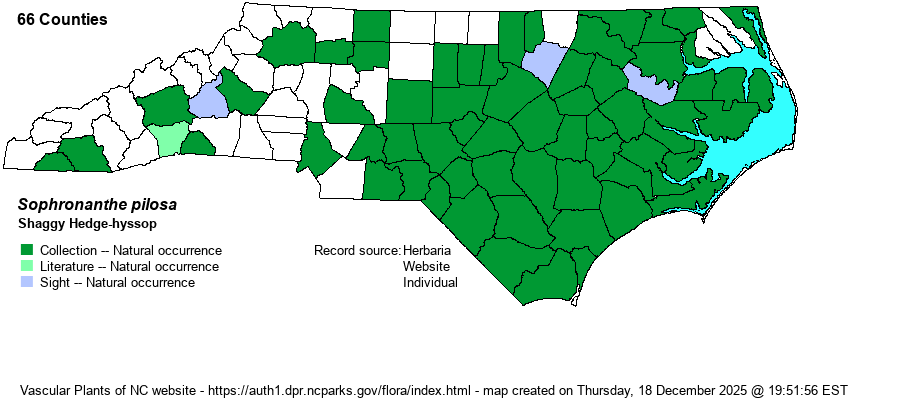| Author | (Michaux) Small | |
| Distribution | Throughout the Coastal Plain. Essentially throughout the eastern third of the Piedmont, west to Granville, Alamance, Randolph, Montgomery, and Anson counties. Widely scattered in the western half of the state, and may be absent in many Mountain counties.
This is a Southern species, ranging from southern NJ and OK, south to southern FL and eastern TX. | |
| Abundance | Common over the entire Coastal Plain, including the Sandhills region. Infrequent to fairly common in the eastern third of the Piedmont, but rare in the central and western portions, as well as in the southern half of the Mountains. The large gap in the range in the southwestern Piedmont is odd, as this is a more southerly species, and should be more widespread there than in the northwestern Piedmont. Why NatureServe has a "?" at the end of the G5 rank is puzzling. Note that the website editors have suggested the State Rank be moved to the more appropriate S5, as it is common in the eastern half of the state. | |
| Habitat | This is a more terrestrial species than the Gratiola species, though still a wetland plant. It grows in pine savannas, ditches, wet grassy places such as low spots in powerline clearings, edges of marshes, grassy seepages, and other mostly sunny and damp ground. | |
| Phenology | Blooms from June into September, and fruits shortly after flowering. | |
| Identification | This is a small and slender herb that grows only to about 8 inches tall, sparingly branched if at all. It is very hairy all over, especially the stem, which should quickly separate it from the essentially glabrous Gratiola species, with which it was placed until recently. It has fairly numerous paired, opposite leaves, sessile, and ovate, about 1/2-inch long and half as wide, usually with a few very small teeth. The flowers, from many leaf axils, are essentially sessile; they are white and about 1/2-inch long, looking essentially like any of the Gratiola species. Normally, it grows in dense patches, and you should be able to identify the species by its very hairy stem, clasping ovate leaves, and sessile flowers (if present). If you spend much time in the Coastal Plain working savannas and other sunny wetlands, you should become quickly familiar with this hedge-hyssop. | |
| Taxonomic Comments | Until recently, it was placed in Gratiola, as Gratiola pilosa. This is now just one of two species in the genus Sophronanthe.
| |
| Other Common Name(s) | Pilose Hedge-hyssop | |
| State Rank | S4 [S5] | |
| Global Rank | G5? | |
| State Status | | |
| US Status | | |
| USACE-agcp | FACW link |
| USACE-emp | FACU link |

